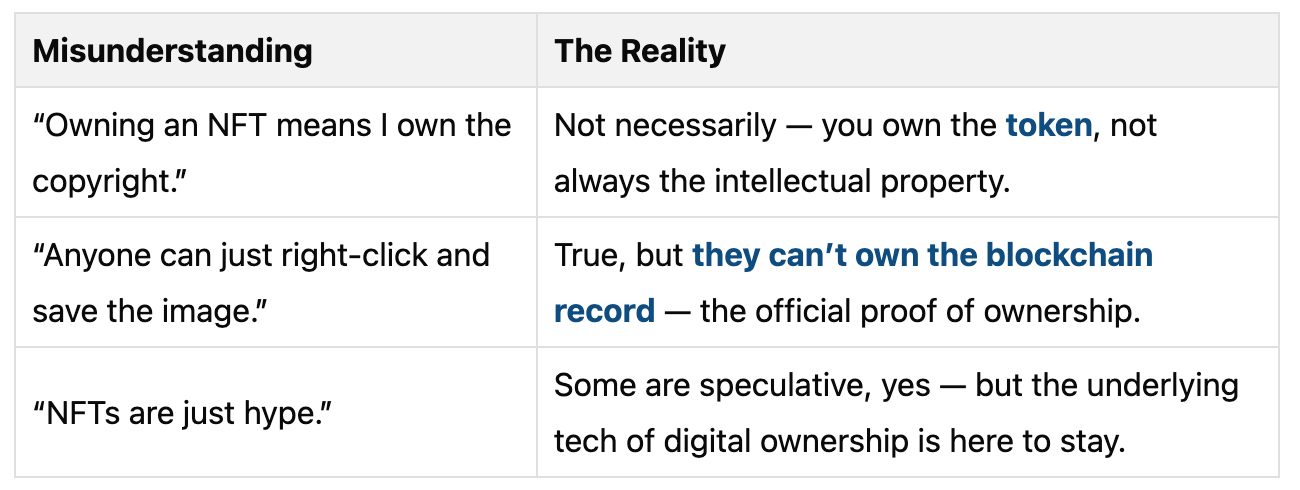10/7/2025
NFTs are unique digital assets that prove ownership of items like art, music, or collectibles on the blockchain.

🧩 What Is an NFT, Really?
NFT stands for Non-Fungible Token — a fancy way of saying a one-of-a-kind digital certificate of ownership stored on a blockchain.
In simple terms, an NFT is like a digital deed or proof of authenticity for something unique online — an artwork, a song, a game item, or even a membership pass.
🎨 A Simple Analogy
Imagine an artist paints a picture.
- The image can be photographed, printed, or shared.
- But there’s only one original canvas — and whoever owns it can prove it’s authentic.
NFTs bring that same idea to the digital world. You can copy the file, but the ownership record — written permanently on the blockchain — can’t be faked or duplicated.
⚙️ How NFTs Work
Here’s the life cycle of a typical NFT:
-
Minting: A creator uploads a digital file (art, music, video, etc.) and “mints” it as an NFT on a blockchain like Ethereum or Solana.
-
Ownership: The blockchain records who owns it. This record is public, permanent, and verifiable by anyone.
-
Trading: NFTs can be bought and sold on marketplaces (like OpenSea or Magic Eden). When ownership changes hands, the blockchain updates automatically.
-
Wallets: Owners keep NFTs in digital wallets — secure apps that act like personal vaults for Web3 assets.
💡 Why People Buy NFTs
NFTs appeal to different people for different reasons:
- Collectors: Want to own something rare or historically significant in the digital world.
- Fans: Support their favorite artists directly and receive exclusive perks.
- Gamers: Use NFTs as in-game items that can be traded or used across multiple games.
- Investors: Speculate that the value of certain NFTs will rise over time.
- Communities: Some NFTs act as digital membership cards — owning one grants access to private groups, events, or rewards.
🧠 Common Misconceptions

⚠️ The Risks You Should Know
Before buying NFTs, keep these in mind:
- Price volatility: Values can swing wildly.
- Scams and fakes: Always verify the creator and smart contract.
- Gas fees: Some blockchains charge transaction fees for minting or transfers.
- Security: Never share your wallet’s private key or seed phrase.
- Legal gray areas: NFT regulation and taxation differ across countries.
🚀 Real-World Uses Beyond Art
NFTs are evolving far beyond profile pictures and collectibles. Some real examples include:
- Gaming: Unique in-game items and player-owned economies.
- Ticketing: Event tickets that can’t be counterfeited or scalped.
- Real Estate: Digital proof of property ownership and transfer.
- Music & Media: Artists selling limited editions directly to fans.
- Digital Identity: NFT-based credentials and memberships.
🌍 Why NFTs Matter for the Future of the Web
NFTs represent the first time in history that people can own something purely digital — not just access or rent it.
They’re part of a larger movement toward Web3, where:
- You control your assets, identity, and data.
- Value flows directly between creators and communities.
- The internet becomes more open, transparent, and user-owned.
🧭 Final Thoughts
NFTs aren’t just a trend — they’re a new building block of digital life. Yes, the hype cycles come and go. But the core idea — verifiable digital ownership — is a fundamental shift in how we create, trade, and experience value online.
In short: NFTs turn digital files into ownable assets, and that’s a game-changer.